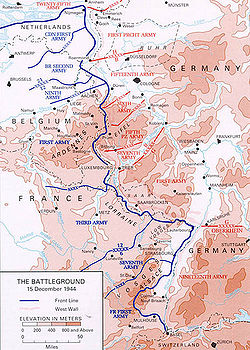Army Group Oberrhein (Germany)
| Army Group Oberrhein | |
|---|---|

The situation at the Upper Rhine on 15 December 1944
|
|
| Active | 26 November 1944 – 25 January 1945 |
| Country |
|
| Branch | German Army (Wehrmacht) |
| Type | Army Group |
| Engagements | World War II |
| Commanders | |
| Notable commanders |
Heinrich Himmler Paul Hausser |
The Upper Rhine High Command (German: Oberkommando Oberrhein), also incorrectly referred to as Army Group Upper Rhine (German: Heeresgruppe Oberrhein), was a short-lived headquarters unit of the German Armed Forces (Wehrmacht) created on the Western Front during World War II. The Upper Rhine High Command was formed on 26 November 1944 and deactivated on 25 January 1945. The sole commander of this headquarters unit was Heinrich Himmler.
Although English language sources refer to this command as an "army group," the German term Oberkommando actually means "high command". As such, the Oberrhein command was not an army group subordinated to theater command, but a command of importance equal to that of a theater command and one which reported directly to Oberkommando der Wehrmacht (OKW) and Adolf Hitler. The German term Oberrhein refers to the upper reaches of the Rhine River, the geographical area for which this command had defense responsibility.
Following successful Allied offensives in November 1944 that forced the Saverne and Belfort Gaps, reached the Rhine River, and liberated Belfort, Strasbourg, and Mulhouse, Hitler ordered the German troops around Colmar in Alsace to hold fast. German Army Group G (Heeresgruppe G) was stripped of defense responsibility for the area around Colmar and the defense of the Rhine River south of the Bienwald.
...
Wikipedia
